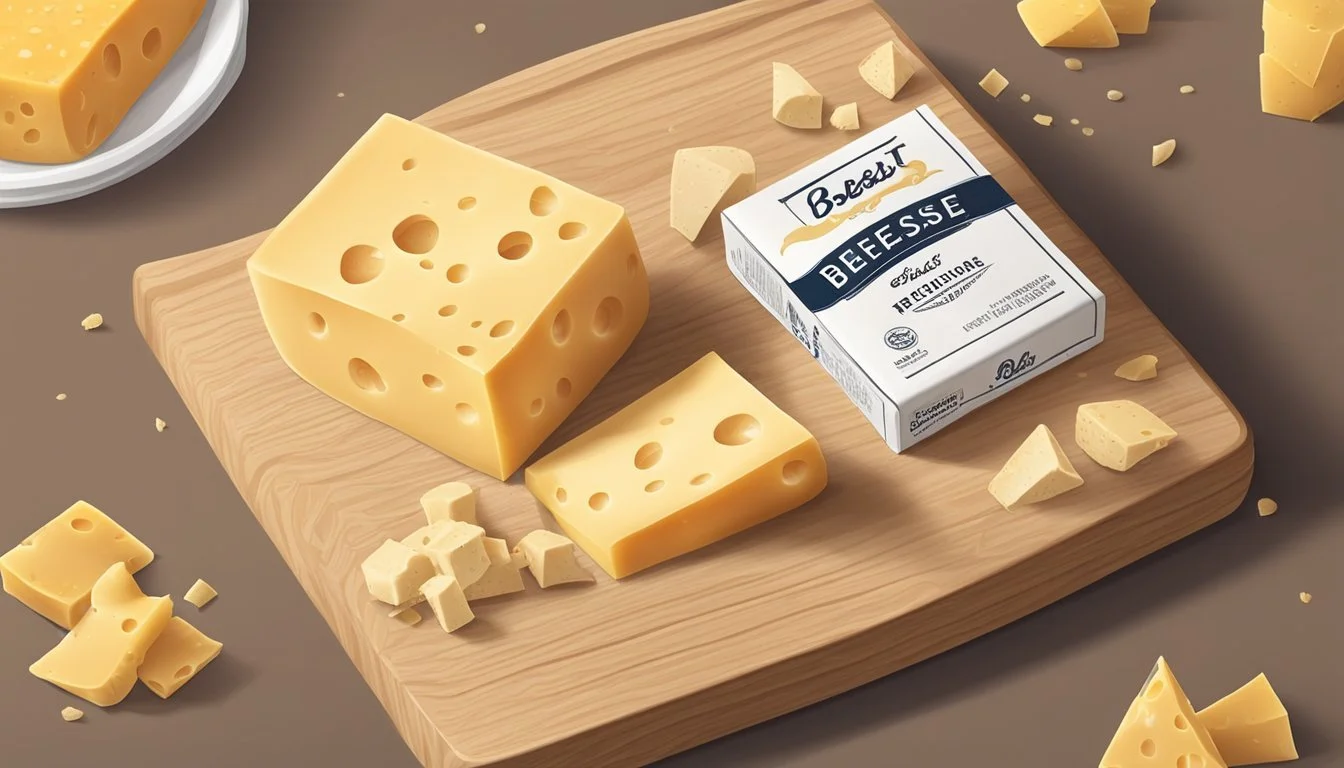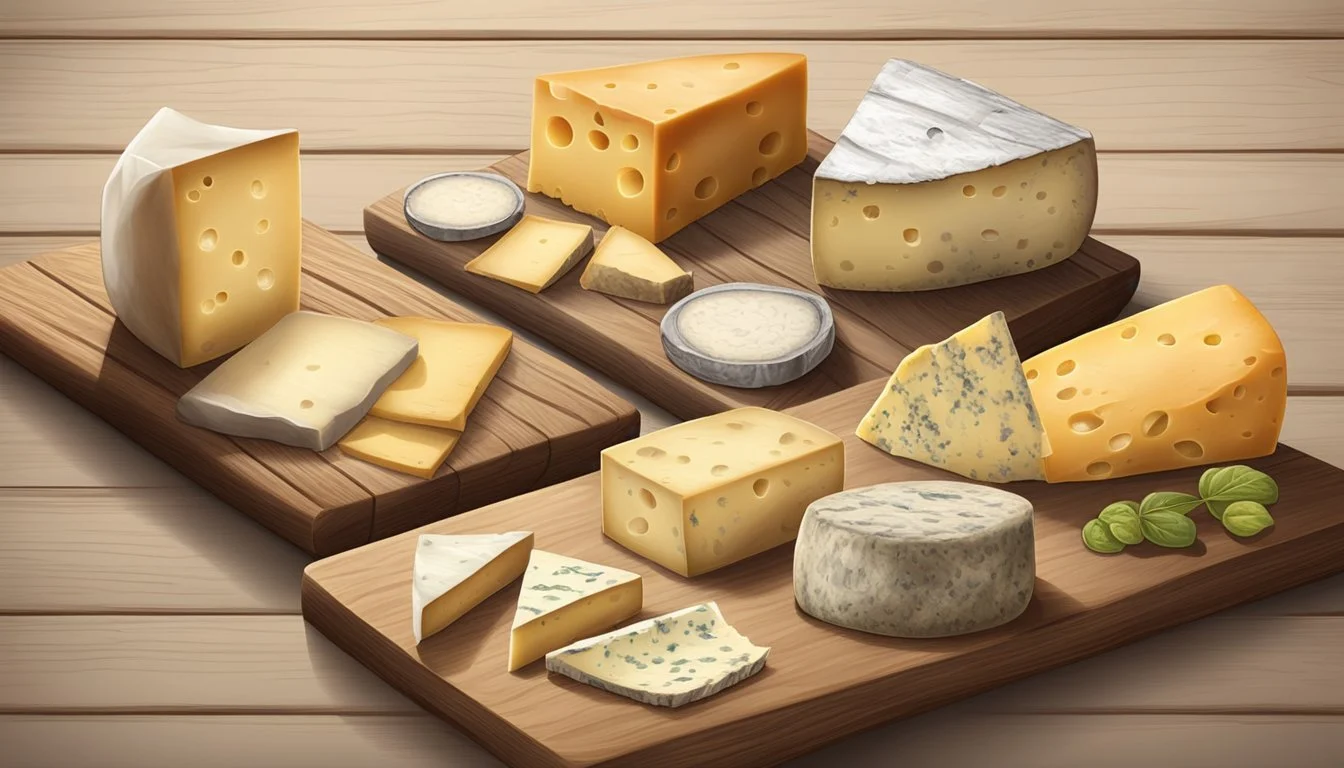How Long Does Cheese Last?
Shelf Life and Storage Tips
When it comes to storing cheese (how long does cheese last?), the shelf life varies greatly depending on the type of cheese (What wine goes well with cheese?) and how it's stored. In general, cheese longevity is influenced by its moisture content. Harder cheeses, which contain less moisture, tend to last longer than softer, more moist cheeses. The storage environment within the fridge, such as temperature and humidity, also plays a significant role in how long cheese remains fresh and safe to consume.
Hard cheeses like cheddar or Parmesan can last for about 3-4 weeks in the fridge after opening, whereas a wheel of Brie or Camembert might have a shorter fridge life due to its higher moisture content. Semi-hard cheeses, like Gouda, can last anywhere from 4 to 6 weeks. It's not unusual for these time frames to extend past the sell-by date so long as the cheese is stored properly.
Knowing the signs of spoilage is important for cheese lovers to prevent waste and avoid consuming spoiled products. Typical signs include mold, sour smell, sliminess on the surface, or dryness. Each variety of cheese will have specific markers for spoilage, with mold being a common indicator that a cheese should no longer be consumed.
Fundamentals of Cheese Preservation
Preserving cheese properly can significantly affect its quality and shelf life. Effective cheese storage hinges on understanding the specific needs of different types of cheese and adhering to the indicated expiration dates.
Types of Cheese
Fresh Cheeses (What wine goes well with fresh cheeses?): Such as mozzarella or ricotta, typically have a high moisture content and spoil more quickly. They should be consumed within a week or two of the best-by date and kept in the refrigerator.
Semi-soft Cheeses (What wine goes well with soft cheeses?): This category includes cheeses like Havarti and Muenster. They can last for several weeks and should be wrapped in breathable material before refrigeration.
Hard Cheeses: Examples include Cheddar and Parmesan. With proper storage, they can last for months. Hard cheeses often develop a harder exterior, which is natural and not necessarily an indication of spoilage.
Blue Cheeses: (What wine goes well with blue cheeses?) Their unique mold content means they can be kept longer than fresh cheeses but should still be consumed within a few weeks to a month after opening.
Understanding Expiration Dates
Best-by Date: This is the date until which the cheese is expected to maintain optimal quality. After this date, the quality may decline, but the cheese could still be safe to eat if stored correctly.
Shelf Life After Opening: Generally, cheese should be consumed within:
Fresh cheese: 1 week
Semi-soft cheese: 2-3 weeks
Hard cheese: 3-6 weeks
Blue cheese: 3-4 weeks
Note: Freezing can extend the life of cheese, but may alter texture.
Signs of Spoilage: Regardless of the best-by date, if cheese shows signs of mold (uncharacteristic to the type), has a sour smell, or an off-taste, it should be discarded.
Storage Conditions and Cheese Longevity
The longevity of cheese significantly depends on its storage conditions, which include proper refrigeration, humidity control, and appropriate wrapping techniques. Maintaining the right environment ensures cheese retains its flavor, texture, and is safe to consume for an extended period.
Refrigeration and Temperature
Refrigeration is crucial for preserving cheese. Different types of cheese may require varying temperatures:
Hard cheeses like Parmesan should be kept in the fridge, ideally at temperatures between 34°F and 38°F.
Soft cheeses, such as Brie, generally benefit from a slightly warmer fridge setting, nearer to 40°F.
Consistency in temperature helps in preventing the cheese from drying out or becoming too moist, which can lead to spoilage.
Humidity and Moisture Control
Humidity levels play a vital role in cheese preservation:
A fridge's humidity should be moderate, not too high to cause excess moisture, which can trigger mold, nor too low which dries out the cheese.
For long-term storage, some cheeses, such as Gouda or Cheddar, are often stored at 45 to 60 degrees in specialized areas like cellars. This range provides an ideal balance that prevents drying while inhibiting the growth of unwanted bacteria.
Proper Wrapping Techniques
The method used to wrap cheese is key to its longevity:
Cheese should be wrapped in parchment paper, cheese paper, or wax paper to allow it to breathe, and then loosely in plastic wrap or foil for protection without trapping moisture.
Butcher paper is another alternative that permits air circulation while maintaining optimal moisture levels.
This dual-layer method helps maintain quality and flavor by preventing the cheese from absorbing strong odors present in the fridge and also inhibits drying and cracking on the surface.
Proper storage extends the enjoyment and edible life of cheese, whether it is a hard, aged variety or a fresh, creamy selection. By following these guidelines, one can ensure that their cheese stays delicious and safe to eat.
Cheese Varieties and Preservation
Cheese preservation varies by type, with the lifespan of cheese largely depending upon its moisture content and how it is stored. Here is a guide to the storage lifespans for different cheese categories.
Hard and Semi-Hard Cheeses
Hard and semi-hard cheeses like Parmesan, Cheddar, Gouda, and Pecorino Romano are known for their low moisture content, which contributes to a longer shelf life. These cheeses can be expected to last:
Hard cheeses (Parmigiano Reggiano, Romano):
Fridge: 3-6 weeks
Freezer: 6-8 months (though freezing can affect texture)
Semi-hard cheeses (Cheddar, Monterey Jack, Gouda):
Fridge: 3-4 weeks
Freezer: not recommended due to texture changes
Soft, Semi-Soft, and Soft-Ripened Cheeses
Soft cheeses such as Ricotta, Mozzarella, Brie, and Camembert have a higher moisture content, making them more perishable than their harder counterparts. Semi-soft and soft-ripened cheeses including Munster and Comté should be consumed somewhat quickly as well:
Soft cheeses (Ricotta, Mozzarella):
Fridge: 1-2 weeks
Semi-soft cheeses (Munster, Monterey Jack):
Fridge: 1-3 weeks depending on packaging
Soft-ripened cheeses (Brie, Camembert):
Fridge: Up to 2 weeks
Processed Cheese Varieties
Processed cheeses, such as American cheese slices and spreads, often contain preservatives that extend their shelf life. This category includes cheeses that do not fit clearly into the hard or soft categories, like processed Feta and Gorgonzola:
Processed hard cheeses (Processed Parmesan, Romano):
Fridge: Up to 6 months unopened
Processed soft cheeses (American cheese, Cheese spreads):
Fridge: Unopened packages can last several months; after opening, consume within 2-3 weeks
Each cheese variety should be stored between 35-45℉ in the fridge for optimal longevity. The right packaging is crucial—cheese should be wrapped in a breathable material like waxed or parchment paper. A storage device such as a Cheese Grotto can provide the ideal humidity for cheese preservation, and a sugar cube placed in the container can help absorb excess moisture.
Preventing Cheese Spoilage
Proper storage and handling of cheese are crucial in preventing spoilage. Recognizing the signs of spoilage and controlling the environmental factors are key to extending the life of cheese.
Identifying Signs of Spoilage
When cheese begins to spoil, it often exhibits a few telltale signs. Consumers should inspect both the smell and the appearance of cheese regularly. Any off-putting smells, akin to ammonia, are indicators that the cheese may no longer be safe to eat. Additionally, visible mold growth, particularly black mold, should be taken seriously as it represents a health hazard.
Sign Description Smell An unpleasant or strong ammonia smell Mold Growth Visible spots or fuzz that can be white, green, red, or black Texture Sliminess or excessive dryness Color Changes or dark spots
Controlling Factors That Lead to Spoilage
Several factors contribute to the spoilage of cheese, with bacteria being the primary cause. To control these factors, cheese should be stored between 35-45℉ (1.7-7.2℃), as this temperature range slows down bacterial growth. Adopting the right type of wrap, such as waxed or parchment paper, allows the cheese to breathe, thus mitigating moisture build-up that can lead to mold and spoilage. For optimal humidity control, a Cheese Grotto, if available, can be used. Should moisture still be a concern, one can place a sugar cube in the storage container to absorb excess.
Extending Cheese Shelf Life
Proper storage methods can significantly extend the cheese's shelf life, particularly through freezing and controlled aging processes. Below are specific techniques tailored for these purposes.
Freezing Cheese
Freezing cheese can halt spoilage by significantly slowing down bacterial growth. To do so effectively, one should divide the cheese into small portions—ideally no more than 1/2 pound each to prevent freeze burn. Before placing the cheese in the freezer, wrap each portion tightly in heavy-duty aluminum foil or plastic wrap. Labeling each portion with the freeze date and type of cheese can help manage the inventory. Most cheeses, except for highly perishable and fresh varieties, handle freezing well. However, textures may change, so frozen cheese is best used for cooking rather than direct consumption.
Cheese Aging and Maturation
Cheese aging, or affinage, is a deliberate process controlled by temperature and humidity to enhance the cheese's flavor and texture. This process relies heavily on fermentation, where bacteria transform the cheese over time. Generally, low-moisture, hard cheeses have a shelf life that extends well beyond their best by date when aged properly. In contrast to freezing, aging should be done under strict conditions and is not suitable for all cheese types. Hard cheeses like Parmesan can benefit most from this method, possibly lasting for months to several years. It is crucial that one monitors the surroundings to maintain consistent conditions for ideal results.
Practical Tips for Consumers
When buying, handling, and cooking with cheese, consumers are advised to pay close attention to packaging, storage methods, and cheese characteristics to maintain taste and ensure quality.
Buying and Handling Cheese
Consumers should select cheese based on its packaging and visible quality. A sealed package with no excess moisture indicates proper handling. Cheese lovers might prefer a package showcasing the rind, which can speak to the authenticity and flavor profile of the cheese. Prioritizing cheeses with a lower water content can also lead to longer shelf-life, especially for hard cheeses.
In terms of storage, the refrigerator's temperature should ideally be within 35-45 degrees Fahrenheit for optimal storage conditions. Cheese should be wrapped in parchment or waxed paper, and then placed in a plastic bag, allowing it to breathe while minimizing exposure to air and potential molds. For hard cheeses, this method of storing can extend their shelf life up to 3-4 weeks. Cheeses with higher moisture content, however, might have a shorter fridge lifespan.
Serving and Cooking With Cheese
Before cooking, allow cheese to reach room temperature to maximize flavor and texture. Cheeses should also be stored properly in-between servings. When cooking, consider the milk origin of the cheese as it can impact both the taste and texture of the final dish.
It's vital to cook cheese at the right temperature based on its water content and the desired consistency. Hard cheeses are better for grating and have a longer refrigerator life, making them more versatile in cooking. They generally fare well with a variety of flavors and can be included in many dishes. To avoid food poisoning, always cook food to the correct internal temperature and avoid cross-contamination.
Pairings and Enjoying Cheese
The art of pairing cheese with complementary foods and beverages can enhance the overall flavor experience. When cheeses are thoughtfully matched with the right partners, their tastes and textures can be elevated, providing a sophisticated gastronomic delight.
Pairing Cheese With Other Foods and Beverages
Pairing cheese with wine is a classic combination, with certain wines bringing out the nuanced flavors of different cheeses. For instance, bold red wines complement firmer cheeses such as Gruyère, while sweet wines or sherry are best suited to counterbalance the funkiness of a blue cheese with a drizzle of honey.
White Wine and Cheese Pairings:
Sauvignon Blanc: Pairs well with tangy cheeses like goat cheese.
Chardonnay: Complements creamy cheeses such as brie.
Red Wine and Cheese Pairings:
Merlot: Excellent with gouda, enhancing its caramel-like flavors.
Cabernet Sauvignon: Matches well with aged cheddar, where each robust flavor meets its match.
Food Pairings: Apart from wine, cheese pairs delightfully with various foods. Here's a quick guide to some food and cheese pairings:
Fruits: Fresh fruits like apples and pears or dried fruits like apricots visually appeal and provide a sweet contrast to a cheese's richness.
Nuts: Walnuts or almonds offer a crunchy texture against the creaminess of softer cheeses.
Honey & Jams: A sweet drizzle of honey or dollop of jam can complement the natural flavors of cheese, especially with stronger, funkier varieties.
Charcuterie: Cured meats (What wine goes well with cured meats?) like prosciutto bring out a cheese's depth of flavor, especially when paired with a robust cheese.
When indulging in cheese pairings, one should not only think about the flavor complementation but also consider the textures and how they interact to create a satisfactory tasting experience.





